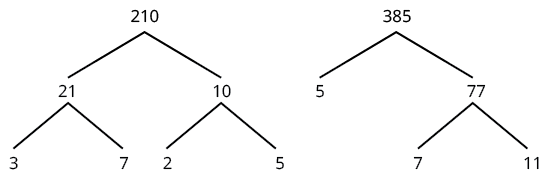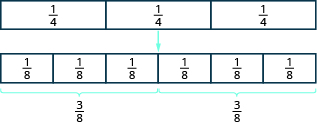| << Chapter < Page | Chapter >> Page > |
Simplify:
| Rewrite the numerator and denominator, showing the common factors, 8. |
|
| Remove common factors. |
|
| Simplify. |
So, the simplified form of is
Sometimes it may not be easy to find common factors of the numerator and denominator. A good idea, then, is to factor the numerator and the denominator into prime numbers. (You may want to use the factor tree method to identify the prime factors.) Then divide out the common factors using the Equivalent Fractions Property.
Simplify:
| Use factor trees to factor the numerator and denominator. |
 |
| Rewrite the numerator and denominator as the product of the primes. | |
| Remove the common factors. |
|
| Simplify. | |
| Multiply any remaining factors. |
We can also simplify fractions containing variables. If a variable is a common factor in the numerator and denominator , we remove it just as we do with an integer factor.
Simplify:
| Rewrite numerator and denominator showing common factors. | |
| Remove common factors. | |
| Simplify. |
A model may help you understand multiplication of fractions. We will use fraction tiles to model To multiply and think of
Start with fraction tiles for three-fourths. To find one-half of three-fourths, we need to divide them into two equal groups. Since we cannot divide the three tiles evenly into two parts, we exchange them for smaller tiles.

We see is equivalent to Taking half of the six tiles gives us three tiles, which is
Therefore,
Use a diagram to model
First shade in of the rectangle.

We will take of this so we heavily shade of the shaded region.

Notice that out of the pieces are heavily shaded. This means that of the rectangle is heavily shaded.
Therefore, of is or
Look at the result we got from the model in [link] . We found that Do you notice that we could have gotten the same answer by multiplying the numerators and multiplying the denominators?
| Multiply the numerators, and multiply the denominators. | |
| Simplify. |
This leads to the definition of fraction multiplication. To multiply fractions, we multiply the numerators and multiply the denominators. Then we write the fraction in simplified form.
If are numbers where then
Multiply, and write the answer in simplified form:
| Multiply the numerators; multiply the denominators. | |
| Simplify. |
There are no common factors, so the fraction is simplified.

Notification Switch
Would you like to follow the 'Prealgebra' conversation and receive update notifications?